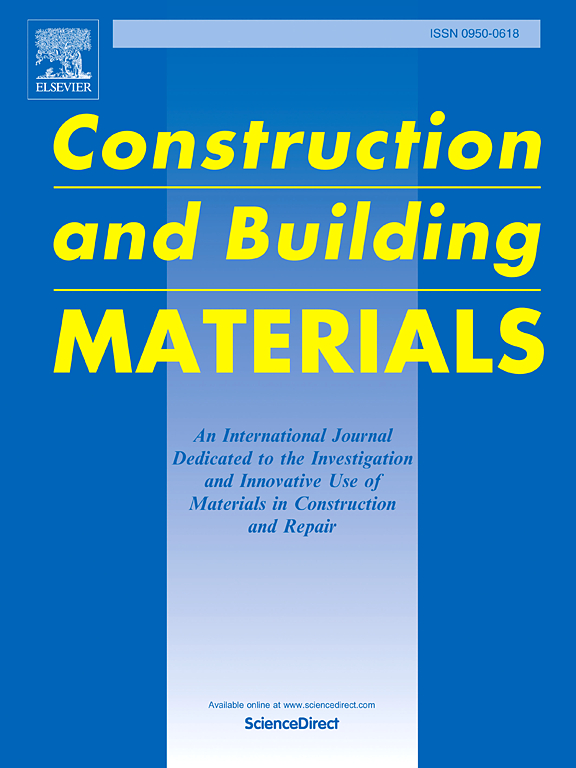工业和再生轮胎钢纤维增强胶凝复合材料在高温条件下的热稳定性和力学性能
IF 7.4
1区 工程技术
Q1 CONSTRUCTION & BUILDING TECHNOLOGY
引用次数: 0
摘要
将再生轮胎钢纤维(RTSF)整合到水泥基材料中,为加强可持续建筑实践提供了一种有前途的方法;然而,对高温下RTSF性能的研究非常有限。本研究考察了RTSF增强胶凝复合材料在0.75和1.0 (%,vol.)剂量下的力学行为,并与工业钢纤维(ISF)增强复合材料和普通对照混合物进行了比较。采用系统的实验方法,在环境温度(约22°C)和300°C和500°C的高温下暴露4小时后,评估复合材料的压缩和弯曲行为。结果表明,在这些条件下,ISF保持完全的质量稳定性,没有质量损失,而RTSF在300°C和500°C时分别逐渐减少0.71 %和1.00 %。在500°C下暴露4小时后,一些测试的平面和纤维增强试件被破坏。显微评价显示出明显的热裂模式,RTSF在300°C时保持其金属光泽,而ISF则表现出降解。对照混合物的弹性模量从22°C时的25.8 GPa显著下降到500°C时的11.9 GPa,而RTSF的弹性模量由于微裂而显著降低。值得注意的是,与对照混合物相比,RTSF-1.0在22°C时表现出最高的强度增益,抗压强度提高了0.7 %,抗弯强度提高了157.1 %,在300°C时达到8.3 MPa的最高抗弯强度,这表明在裂纹止裂和减少氯化物渗透方面具有潜在的好处。这些发现为RTSF应用于耐火基础设施的可行性提供了基础见解,强调了优化纤维用量以提高性能的重要性。本文章由计算机程序翻译,如有差异,请以英文原文为准。
Thermal stability and mechanical behavior of cementitious composites reinforced with industrial and recycled tire steel fibers under elevated temperature conditions
The integration of Recycled Tire Steel Fibers (RTSF) into cement-based materials offers a promising approach to enhancing sustainable construction practices; however, research on the performance of RTSF under elevated temperatures is critically limited. This study investigates the mechanical behavior of cementitious composites reinforced with RTSF at dosages of 0.75 and 1.0 (%, vol.), in comparison to composites reinforced with industrial steel fibers (ISF) and a plain control mixture. A systematic experimental methodology was employed, wherein the composites' compressive and flexural behaviors were assessed at ambient temperature (approximately 22°C) and after exposure to elevated temperatures of 300°C and 500°C for four hours. The results indicate that ISF maintained complete mass stability under these conditions, exhibiting no mass loss, whereas RTSF experienced gradual reductions of 0.71 % and 1.00 % at 300°C and 500°C, respectively. Following a four-hour exposure to 500°C, some of the tested plain and fiber-reinforced specimens were damaged. Microscopic evaluations revealed distinct thermal cracking patterns, with RTSF retaining its metallic sheen at 300°C while ISF showed degradation. The elastic modulus of the control mix decreased significantly from 25.8 GPa at 22°C to 11.9 GPa at 500°C, while RTSF demonstrated notable reductions in modulus due to microcracking. Notably, RTSF-1.0 demonstrated the highest strength gains at 22°C, with a 0.7 % increase in compressive strength and a 157.1 % increase in flexural strength compared to the control mix, and achieved the highest flexural strength of 8.3 MPa at 300°C, indicating potential benefits in crack arrest and chloride penetration reduction. These findings provide foundational insights into the viability of RTSF for applications in fire-resistant infrastructure, which highlights the importance of optimizing fiber dosage for enhanced performance.
求助全文
通过发布文献求助,成功后即可免费获取论文全文。
去求助
来源期刊

Construction and Building Materials
工程技术-材料科学:综合
CiteScore
13.80
自引率
21.60%
发文量
3632
审稿时长
82 days
期刊介绍:
Construction and Building Materials offers an international platform for sharing innovative and original research and development in the realm of construction and building materials, along with their practical applications in new projects and repair practices. The journal publishes a diverse array of pioneering research and application papers, detailing laboratory investigations and, to a limited extent, numerical analyses or reports on full-scale projects. Multi-part papers are discouraged.
Additionally, Construction and Building Materials features comprehensive case studies and insightful review articles that contribute to new insights in the field. Our focus is on papers related to construction materials, excluding those on structural engineering, geotechnics, and unbound highway layers. Covered materials and technologies encompass cement, concrete reinforcement, bricks and mortars, additives, corrosion technology, ceramics, timber, steel, polymers, glass fibers, recycled materials, bamboo, rammed earth, non-conventional building materials, bituminous materials, and applications in railway materials.
 求助内容:
求助内容: 应助结果提醒方式:
应助结果提醒方式:


